
Annual chores for fruit trees
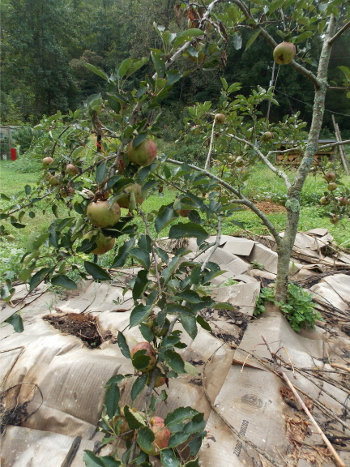 "I was wondering if there
is something you do to your fruit trees each year to help them
grow.
I have just started doing that espalier
thing for my trees. It is their first year, I put in aged horse
manure and mulch around each tree. But I was wondering what type
of annual chores your do for your trees."
"I was wondering if there
is something you do to your fruit trees each year to help them
grow.
I have just started doing that espalier
thing for my trees. It is their first year, I put in aged horse
manure and mulch around each tree. But I was wondering what type
of annual chores your do for your trees."
I'm a very hands-on
gardener, so even our fruit trees (the lowest -maintenance parts
of our garden) get a lot of care scattered throughout the
year. It starts with pruning
and feeding each tree in late winter, the latter generally being a
topdressing
of horse manure scattered very lightly underneath the
canopy. In a perfect world, I would mulch each tree at the
same time I fertilize it, then keep topping up the mulch as needed
throughout the year, but in reality our older trees tend to have
small weeds grow up underneath by summer, then Mark cuts the
growth back a couple of times with a weedeater. If I have
extra cardboard, I may lay down a kill mulch instead, which is
particularly handy around younger trees who can't stand much
competition.
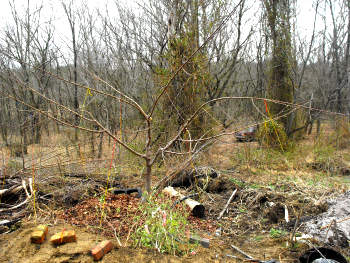 Younger trees also get more
structural attention in the summer when I prune a second time (removing
watersprouts) and train the limbs into shape. At the
moment, I'm training
peaches to the open center system (which I love) and apples
to the central-leader system (which I'm not as sure about
yet). After they start fruiting, most trees will begin to
maintain their shape on their own and will need less summer
pruning and training, but the warm-weather attention is very handy
with young trees since it keeps them on track to produce the
growth you really want while they're small.
Younger trees also get more
structural attention in the summer when I prune a second time (removing
watersprouts) and train the limbs into shape. At the
moment, I'm training
peaches to the open center system (which I love) and apples
to the central-leader system (which I'm not as sure about
yet). After they start fruiting, most trees will begin to
maintain their shape on their own and will need less summer
pruning and training, but the warm-weather attention is very handy
with young trees since it keeps them on track to produce the
growth you really want while they're small.
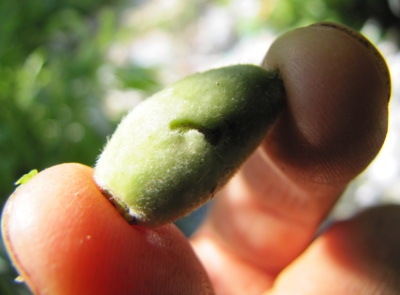 Speaking of fruit, I start
paying attention to the developing fruits as soon as the petals
drop. I worry myself sick about late frosts (although I've
yet to come up with any preventative that works there), then after
the last freeze, I thin
the tiny fruits hard. I think thinning is one of the
most-overlooked aspects of getting high-quality fruit in the
backyard --- don't skip it! I also perform some pest
management, which mostly consists of removing troubled fruits and
twigs.
Speaking of fruit, I start
paying attention to the developing fruits as soon as the petals
drop. I worry myself sick about late frosts (although I've
yet to come up with any preventative that works there), then after
the last freeze, I thin
the tiny fruits hard. I think thinning is one of the
most-overlooked aspects of getting high-quality fruit in the
backyard --- don't skip it! I also perform some pest
management, which mostly consists of removing troubled fruits and
twigs.
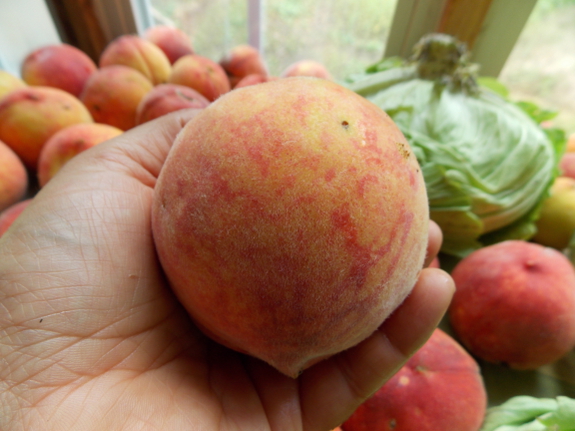 Finally, I pick
and pick and pick! I've learned that fruits on the
same tree don't ripen all at once, and I get a much better harvest
if I pluck
early fruits as soon as they start to develop infection,
then keep picking problematic or particularly ripe fruits as the
season proceeds. We gorge on fruits, dry them, then give
extras away or experiment with other preservation techniques.
Finally, I pick
and pick and pick! I've learned that fruits on the
same tree don't ripen all at once, and I get a much better harvest
if I pluck
early fruits as soon as they start to develop infection,
then keep picking problematic or particularly ripe fruits as the
season proceeds. We gorge on fruits, dry them, then give
extras away or experiment with other preservation techniques.
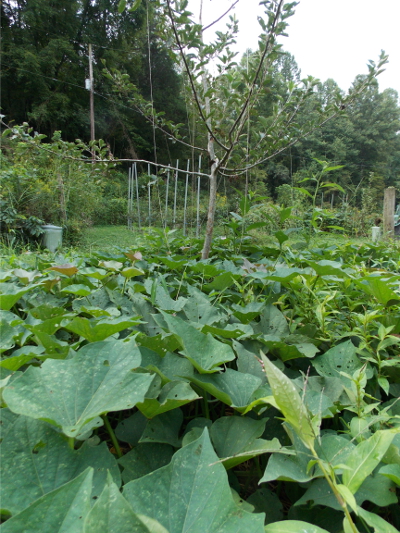 That's the bare bones of
our fruit-tree management schedule, but, of course, I'm always
experimenting with new techniques. For example, this summer,
I'm trying out sweet potatoes planted beyond the tree canopies
then used as a living, noncompetitive groundcover under the
trees. Last winter, I started experimenting with grafting
new varieties onto medium-sized pear trees, and next year my
dwarfing apple rootstock will be big enough to stool
and propagate to extend our high-density
planting. But that's all advanced tree husbandry ---
the techniques mentioned previously should be enough to get you
off to a very good start.
That's the bare bones of
our fruit-tree management schedule, but, of course, I'm always
experimenting with new techniques. For example, this summer,
I'm trying out sweet potatoes planted beyond the tree canopies
then used as a living, noncompetitive groundcover under the
trees. Last winter, I started experimenting with grafting
new varieties onto medium-sized pear trees, and next year my
dwarfing apple rootstock will be big enough to stool
and propagate to extend our high-density
planting. But that's all advanced tree husbandry ---
the techniques mentioned previously should be enough to get you
off to a very good start.
Want more in-depth information? Browse through our books.
Or explore more posts by date or by subject.
About us: Anna Hess and Mark Hamilton spent over a decade living self-sufficiently in the mountains of Virginia before moving north to start over from scratch in the foothills of Ohio. They've experimented with permaculture, no-till gardening, trailersteading, home-based microbusinesses and much more, writing about their adventures in both blogs and books.
Want to be notified when new comments are posted on this page? Click on the RSS button after you add a comment to subscribe to the comment feed, or simply check the box beside "email replies to me" while writing your comment.
- Remove comment
